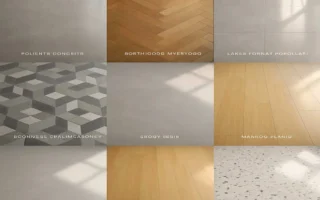The hardwood flooring you choose can change the look and feel of your home. It should also fit your lifestyle.
If you have pets, kids, or love older-style homes, your flooring needs certain features. Think about durability, upkeep, and style to make sure it works for you.
So, how do you find flooring that’s both beautiful and tough? Here are nine simple tips to guide your choice.
1. Assess Your Lifestyle
Consider how you use your space daily-do you have kids, pets, or frequent guests? High-traffic areas may require more durable options like oak or hickory, while a quieter household can enjoy softer woods like walnut. Think about your cleaning habits and maintenance preferences, too.
Some hardwood finishes are better at hiding scratches and stains, making them ideal for busy homes. Matching your floor’s durability, finish, and style with your household’s needs ensures beauty and functionality for years. By assessing your lifestyle first, you’ll choose a hardwood floor that not only enhances your home but also withstands your everyday activities.
2. Consider Your Home’s Traffic
High-traffic areas require a floor that can withstand frequent wear and tear. Entryways and hallways are prime examples. You can opt for a tougher hardwood species or think about finishes that enhance durability. A good finish can help protect against scratches and scuff marks, prolonging the life of your hardwood flooring.
3. Evaluate Maintenance Needs
One helpful tip for choosing the right hardwood floor for your lifestyle is to evaluate maintenance needs before deciding. Different hardwood types and finishes require varying levels of care. For example, matte or textured finishes can hide dust and scratches better, reducing the need for frequent cleaning, while glossy finishes may require more upkeep to maintain their shine.
Some hardwoods are more resistant to dents and wear, making them easier to maintain in busy households. Consider how much time and effort you’re willing to invest in cleaning, polishing, and refinishing.
If you prefer low-maintenance options, engineered hardwood might be ideal for any room in the home, including basements and areas with changing humidity.. By understanding maintenance requirements, you can choose a hardwood floor that stays beautiful without overwhelming your routine.
4. Opt for Quality Over Price
While it can be tempting to choose a cheaper option, low-quality hardwood may wear out faster, show damage sooner, and require costly repairs or replacements. High-quality hardwood, on the other hand, offers better durability, finish, and resistance to daily wear, making it a smarter long-term investment.
Premium materials often have stronger cores, better grain patterns, and protective coatings that preserve their beauty for years. Remember, flooring is a significant part of your home’s look and function, so it’s worth investing in a product that can stand up to your lifestyle while maintaining its elegance and value over time
5. Choose the Right Finish
The finish not only enhances the wood’s beauty but also affects its durability and maintenance needs. For active households with kids or pets, a matte or satin finish can help conceal scratches, scuffs, and dust, keeping your floors looking cleaner for longer. Glossy finishes, while elegant, may highlight imperfections and require more frequent upkeep.
Some finishes also provide stronger protective layers against moisture and wear, making them ideal for high-traffic areas. By matching the finish to your daily activities, cleaning habits, and style preferences, you can enjoy hardwood flooring that remains both practical and visually stunning for many years.
6. Match Colors and Styles to Your Home
Hardwood flooring comes in a wide variety of styles and colors. When selecting colors, consider your overall home decor. Darker woods can lend a sense of elegance and warmth, while lighter woods, like bamboo, can create an airy, open feel.
Ensure the style of your flooring complements the existing features of your home. Color swatches in different lighting conditions can help you make a more informed decision.
7. Think About the Installation Process
Different types of hardwood have varying installation methods, which can affect cost, time, and convenience. Solid hardwood often requires professional installation and acclimation time, making it ideal for long-term homes. Engineered hardwood, on the other hand, can be easier and faster to install, sometimes even as a DIY project with click-lock systems.
Consider whether you can handle a longer installation period or if you need a quick turnaround. Also, think about the disruption to your daily routine during the process. By understanding the installation requirements, you can choose a hardwood option that fits both your schedule and your living situation.
8. Research Environmental Impact
As sustainability becomes increasingly important, it’s wise to research the environmental impact of your hardwood flooring choice. Look for options certified by the Forest Stewardship Council (FSC) to ensure that your flooring is sourced from sustainable forests. Additionally, you may find reclaimed wood flooring appealing, which adds character while reducing waste.
9. Test Samples
Seeing a small piece in a showroom is different from how it will look in your own space. Order samples and place them in different areas of your home to observe how they react to natural and artificial lighting throughout the day. Testing also helps you see how the color, grain, and finish match your furniture and décor.
You can even check how well the sample hides dust, pet hair, or minor scratches. By physically interacting with the samples, you’ll get a clearer idea of the hardwood’s look and feel, ensuring your final choice perfectly fits your home and lifestyle.
Select Hardwood Flooring That Suits Your Lifestyle
Choosing hardwood flooring doesn’t have to be hard. Break the process into small steps. Think about your lifestyle and what you need in terms of strength, upkeep, color, and style. This will help you pick a floor that looks good and works well for your home.
When you’re ready, talk to flooring experts. They can give you useful advice and help you make your final choice. This way, your new floor will match your home and the way you live.
Looking for more tips and advice? You’re in the right place! Make sure to bookmark our page and come back to check out more interesting articles.




